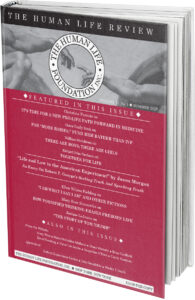My Cardinal to the End
[This article appeared in a slightly shorter form in First Things on May 3, 2010, ten years after the death of Cardinal John O’Connor. It is reprinted here, with the magazine’s permission, to mark the 25th anniversary of the beloved Cardinal’s passing.]
I first got to know Cardinal O’Connor from his weekly column in Catholic New York. His personal and confessional style drew me closer to a Church I had drifted away from in my 20s, and I looked forward each week to reading his thoughts on the latest news item or his memories of growing up in Philadelphia’s Catholic “ghetto.”
I was a sports journalist at the time, dealing in the unchangeable facts of box scores and final standings. The cardinal’s column intrigued me because he appealed to another sort of truth. There was a simple humility of facts built upon facts that led to faith, or was it faith that informed the facts and made them intelligible? Whatever the dynamic, Cardinal O’Connor won my heart because I knew that someone greater had won his. I wanted to know that someone else.
In 1984 I was on the fence of the issue of our time – abortion. My libertarian leanings had me thinking that a little growth inside the womb was like a hangnail that could be snipped off at will. Yet something deep inside me said a world like that could only be cold and cruel, and I knew no one could live there long. Cardinal O’Connor again convinced me.
I was happily back at Mass, indulging in the Real Presence and the mystery of forgiveness, when I read his response to Mario Cuomo’s famous Notre Dame speech. I had seen the New York Times’ coverage of Cuomo and the hoorays that followed, but I failed to follow his argument. It was a speech poised solely for effect and was accepted only for its conclusion – you can be Catholic and “pro-choice”. After reading the cardinal’s response I understood why Cuomo’s stand was so popular. To abandon the calculated “personally opposed but” position was to realize the horror that has been unleashed on our land and the obligation to stop it. To take the side of O’Connor, which was to take actions and their consequences seriously, was to become a modern-day abolitionist. Soon I was praying outside of abortion clinics and counseling women, as part of our nation’s longest-running grass-roots social movement.
When it came time to finally decide what to do with my new-found life as a Bible reading, rosary toting, daily Mass Catholic, I read these words of Cardinal O’Connor: “Priests Needed.” He asked in his column for single men, devoted to the faith, who were willing to take on the sufferings of the people by standing at the altar of God. I signed up to be his seminarian.
I finally got to meet him in the flesh when I served Mass with my classmates at St. Patrick’s Cathedral. “Well done, well did, well deed,” he joked, as he thanked the servers after Mass, extending his bony hand. One time when I held up the thurible for him to pour in incense, he sensed my tense uncertainty and dropped a few grains down the sleeve of my cassock. He smiled that warm smile that said to me he understood everything and told me not to worry, without a word. I was not called to be his priest, to serve in his ranks for the salvation of souls. God had another plan, and it was the cardinal who helped me see it, once again.
I left the seminary and became a reporter for Catholic New York, his weekly newspaper, where my journey back to the Church had begun. I got to match my love of writing with my love of the Church, and record the words of the cardinal each week, as he preached from the nation’s most visible pulpit and made front-page news with his comments on abortion, politicians, exorcism and his fight with Mayor Koch over condoms and conscience. “O’C” was a fixture for the New York Post’s headline writers, and at Catholic New York we prided ourselves in telling the story behind the sensation and sound bites. Fellow journalists asked me if I felt constrained by writing for the Church, and I always said no. I got to tell the whole story, with the full truth of the Gospel and the Christian understanding of the human person as my sources. What were the vagaries of the daily news cycle compared to the Sermon on the Mount?
After what he described to his brother bishops as “a great ride,” Cardinal O’Connor fell ill with cancer but did not succumb. He was active until the last possible day, still preaching, teaching and making converts out of seekers like me. I was privileged to cover his funeral Mass, and was there when a pro-life ovation erupted in the cathedral in the presence of a host of pro-abortion politicians. It was a great time to be alive, to be Catholic, to be pro-life and fired with faith. It was a moment brought about by Cardinal O’Connor, who even in death, was a witness for life.










Wonderful tribute to a great churchman. My wife and I had the privilege of lunching with him. We were early supporters of the Sisters of Life and he wanted to thank us.